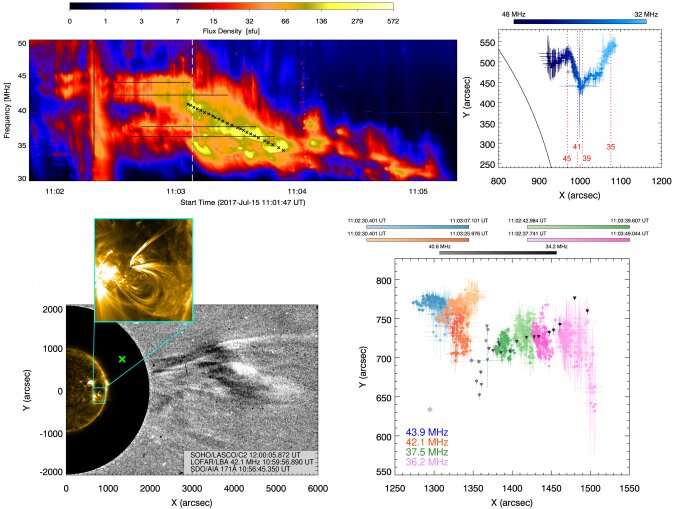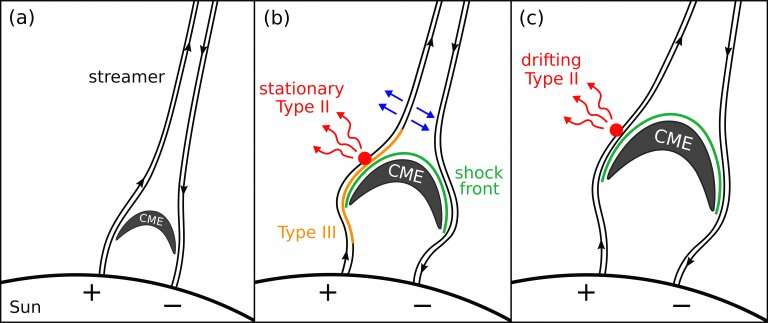First observation of a transitioning Type II solar radio burst using LOFAR

Type II solar radio bursts are believed to be excited by shock waves. They are often linked to shocks driven by solar eruptive events like coronal mass ejections (CMEs) and solar flares, and are characterized by a slow drift from high to low frequencies thought to reflect the speed with which the shock propagates away from the sun. Shock-excited emissions that show very little or no frequency drift are known as "stationary Type II bursts" (e.g. Aurass et al. 2002). Stationary Type II bursts are sometimes interpreted as termination shocks in solar flares (e.g., Chen et al. 2019).
Recently, Chrysaphi et al. (2020) have reported for the first time a Type II burst that transitions between a stationary and drifting state (see Figure 1), and discussed the possible mechanisms leading to the transitioning Type II burst.
The radio emissions presented in the current study presented several interesting aspects beyond the transitioning state of the Type II burst. Band splitting was observed during the stationary Type II emissions at two different but simultaneous locations (see Figure 1). Intriguing fine structures with both negative- and positive-frequency drift rates were also identified within the stationary Type II burst. A Type III burst that intersected the stationary Type II emissions was also observed.
We used LOFAR's imaging capabilities to examine the behavior of the Type II sources before, during and after the transition from a stationary to a drifting state. For this purpose, the Type II sources were imaged at frequencies representing each of the four subbands (see Figure 1). A single frequency was used for each subband in order to eliminate the effects of the frequency-dependent propagation effects, like scattering (see e.g., Chrysaphi et al. 2018 and Kontar et al. 2019), and present the pure temporal motion of the sources throughout the transition. A jump in the Type II source locations was identified at the time of the transition from stationary to drifting states. The Type III burst was imaged across several frequencies and at a single moment in time. The relative locations of sources imaged at different frequencies were corrected for the scattering-induced displacement using the simple, analytical method derived by Chrysaphi et al. (2018). As indicated in Figure 1, there were abrupt shifts in the path laid out by the Type III sources. These shifts occurred at frequencies that coincided with the frequencies of the Type II subbands.

We examined multi-wavelength observations to identify solar activities that were spatially and temporally related to the radio emissions. A jet eruption was observed near the time of the radio emissions. The spire of the jet bifurcated into two components that are believed to have driven two CME fronts (see Figure 1). We found that one of the bifurcated jet components produced a streamer-puff CME (Bemporad et al. 2005), which was linked to the radio emissions. First described by Bemporad et al. (2005), streamer-puff CMEs are a variety of narrow CMEs that propagate along a streamer, inflating it, but leaving it intact.
The mechanisms that we believe generated the observed radio emissions are presented schematically in Figure 2. The eruption of the jet results in a streamer-puff CME that propagates along the already existing streamer, as indicated in Figure 2 (a). As the CME accelerates and forms a shock (green curve), the shock interacts with the open magnetic fields forming the streamer, causing the streamer to undergo a localized expansion near the flanks of the CME, but not yet at its nose (Figure 2 (b)). Regions of the shock are halted by the interplay with the streamer, effectively behaving as a standing shock. We believe that at this stage (Figure 2 (b)), three nearly simultaneous actions take place:
- The compression between the shock and the streamer excite the stationary Type II emissions (shown in red)
- The interplay between the shock and the streamer causes the streamer to pulsate (blue arrows), exciting the negative and positive frequency-drift fine structures within the stationary Type II emissions
- An electron beam traces the open magnetic fields, confining the locally expanded streamer, exciting a Type III burst (orange curve), of which the source locations reflect the local inflation of the streamer
The final stage (Figure 2 (c)) is when the CME forces the streamer to succumb to its expansion, even around the nose of the CME, allowing for the smooth propagation of the CME along the streamer. It is at this moment that the region of the shock exciting the radio emissions transitions from a standing to a drifting shock, and the streamer structure that was pulsating abruptly jumps to a new, stable location, causing the jump in the observed Type II sources. The CME continues to expand as it propagates away from the sun and the constant compression against the streamer excites the drifting Type II emissions (shown in red, Figure 2 (c)).
More information: Nicolina Chrysaphi et al. First Observation of a Type II Solar Radio Burst Transitioning between a Stationary and Drifting State, The Astrophysical Journal (2020). DOI: 10.3847/1538-4357/ab80c1
Journal information: Astrophysical Journal
Provided by Community of European Solar Radio Astronomers




















